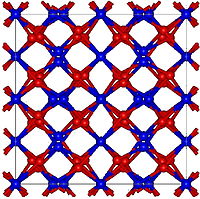Thallium(III) oxide
 |
|
| Names | |
|---|---|
| Other names
thallium trioxide, thallium sesquioxide
|
|
| Identifiers | |
|
1314-32-5 |
|
| 3D model (Jmol) | Interactive image |
| ChemSpider |
7979876 |
| ECHA InfoCard | 100.013.846 |
| EC Number | 215-229-3 |
| PubChem | 9804116 |
|
|
|
|
| Properties | |
| Tl2O3 | |
| Molar mass | 456.76 g/mol |
| Appearance | very dark, nearly black solid |
| Density | 10.19 g/cm3, solid (22 °C) |
| Melting point | 717 °C (1,323 °F; 990 K) |
| Boiling point | 875 °C (1,607 °F; 1,148 K) (decomposes) |
| insoluble | |
| +76.0·10−6 cm3/mol | |
| Structure | |
| Cubic, cI80 | |
| Ia-3, No. 206 | |
| Hazards | |
|
EU classification (DSD)
|
not listed |
| NFPA 704 | |
| Lethal dose or concentration (LD, LC): | |
|
LD50 (median dose)
|
44 mg/kg (oral, rat) |
|
Except where otherwise noted, data are given for materials in their standard state (at 25 °C [77 °F], 100 kPa).
|
|
|
|
|
| Infobox references | |
Thallium(III) oxide is a chemical compound of thallium and oxygen. It occurs in nature as the rare mineral avicennite. Its structure is related to that of Mn2O3 which has a bixbyite like structure. Tl2O3 is metallic with high conductivity and is a degenerate n-type semiconductor which may have potential use in solar cells. A method of producing Tl2O3 by MOCVD is known. Any practical use of thallium(III) oxide will always have to take account of thallium's poisonous nature. Contact with moisture and acids may form poisonous thallium compounds.
It is produced by the reaction of thallium with oxygen or hydrogen peroxide in an alkaline thallium(I) solution. Alternatively, it can be created by the oxidation of thallium(III) nitrate by chlorine in an aqueous potassium hydroxide solution.
...
Wikipedia

